Structures of β-klotho reveal a 'zip code'-like mechanism for endocrine FGF signalling
- PMID: 29342135
- PMCID: PMC6594174
- DOI: 10.1038/nature25010
Structures of β-klotho reveal a 'zip code'-like mechanism for endocrine FGF signalling
Abstract
Canonical fibroblast growth factors (FGFs) activate FGF receptors (FGFRs) through paracrine or autocrine mechanisms in a process that requires cooperation with heparan sulfate proteoglycans, which function as co-receptors for FGFR activation. By contrast, endocrine FGFs (FGF19, FGF21 and FGF23) are circulating hormones that regulate critical metabolic processes in a variety of tissues. FGF19 regulates bile acid synthesis and lipogenesis, whereas FGF21 stimulates insulin sensitivity, energy expenditure and weight loss. Endocrine FGFs signal through FGFRs in a manner that requires klothos, which are cell-surface proteins that possess tandem glycosidase domains. Here we describe the crystal structures of free and ligand-bound β-klotho extracellular regions that reveal the molecular mechanism that underlies the specificity of FGF21 towards β-klotho and demonstrate how the FGFR is activated in a klotho-dependent manner. β-Klotho serves as a primary 'zip code'-like receptor that acts as a targeting signal for FGF21, and FGFR functions as a catalytic subunit that mediates intracellular signalling. Our structures also show how the sugar-cutting enzyme glycosidase has evolved to become a specific receptor for hormones that regulate metabolic processes, including the lowering of blood sugar levels. Finally, we describe an agonistic variant of FGF21 with enhanced biological activity and present structural insights into the potential development of therapeutic agents for diseases linked to endocrine FGFs.
Figures

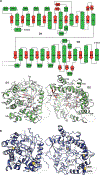



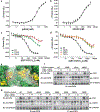



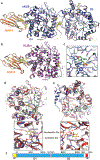
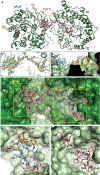
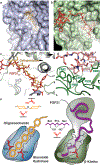

Comment in
-
Ageing-related receptors resolved.Nature. 2018 Jan 25;553(7689):409-410. doi: 10.1038/d41586-017-09032-4. Nature. 2018. PMID: 29368738 No abstract available.
-
Unraveling Endocrine FGF Signaling Complex to Combat Metabolic Diseases.Trends Biochem Sci. 2018 Aug;43(8):563-566. doi: 10.1016/j.tibs.2018.05.001. Epub 2018 Jun 9. Trends Biochem Sci. 2018. PMID: 29895507
Similar articles
-
Structures of ligand-occupied β-Klotho complexes reveal a molecular mechanism underlying endocrine FGF specificity and activity.Proc Natl Acad Sci U S A. 2019 Apr 16;116(16):7819-7824. doi: 10.1073/pnas.1822055116. Epub 2019 Apr 3. Proc Natl Acad Sci U S A. 2019. PMID: 30944224 Free PMC article.
-
The structural biology of the FGF19 subfamily.Adv Exp Med Biol. 2012;728:1-24. doi: 10.1007/978-1-4614-0887-1_1. Adv Exp Med Biol. 2012. PMID: 22396159 Free PMC article. Review.
-
Agonistic β-Klotho antibody mimics fibroblast growth factor 21 (FGF21) functions.J Biol Chem. 2018 Sep 21;293(38):14678-14688. doi: 10.1074/jbc.RA118.004343. Epub 2018 Aug 1. J Biol Chem. 2018. PMID: 30068552 Free PMC article.
-
The Saga of Endocrine FGFs.Cells. 2021 Sep 14;10(9):2418. doi: 10.3390/cells10092418. Cells. 2021. PMID: 34572066 Free PMC article. Review.
-
A systematic dissection of sequence elements determining β-Klotho and FGF interaction and signaling.Sci Rep. 2018 Jul 23;8(1):11045. doi: 10.1038/s41598-018-29396-5. Sci Rep. 2018. PMID: 30038432 Free PMC article.
Cited by
-
Klotho in Clinical Nephrology: Diagnostic and Therapeutic Implications.Clin J Am Soc Nephrol. 2020 Dec 31;16(1):162-176. doi: 10.2215/CJN.02840320. Epub 2020 Jul 22. Clin J Am Soc Nephrol. 2020. PMID: 32699047 Free PMC article. Review.
-
Development of Zalfermin, a Long-Acting Proteolytically Stabilized FGF21 Analog.J Med Chem. 2024 Jul 25;67(14):11769-11788. doi: 10.1021/acs.jmedchem.4c00391. Epub 2024 Jul 16. J Med Chem. 2024. PMID: 39013015 Free PMC article.
-
FGFR redundancy limits the efficacy of FGFR4-selective inhibitors in hepatocellular carcinoma.Proc Natl Acad Sci U S A. 2022 Oct 4;119(40):e2208844119. doi: 10.1073/pnas.2208844119. Epub 2022 Sep 30. Proc Natl Acad Sci U S A. 2022. PMID: 36179047 Free PMC article.
-
The Body-wide Transcriptome Landscape of Disease Models.iScience. 2018 Apr 27;2:238-268. doi: 10.1016/j.isci.2018.03.014. Epub 2018 Mar 29. iScience. 2018. PMID: 30428375 Free PMC article.
-
An Open-Label Exploratory Clinical Trial Evaluating the Effects of GLS (Coptidis Rhizoma-Evodiae Fructus 2 : 1) on Fibroblast Growth Factor 21 in Patients with Nonalcoholic Fatty Liver Disease.Evid Based Complement Alternat Med. 2022 Mar 23;2022:4583645. doi: 10.1155/2022/4583645. eCollection 2022. Evid Based Complement Alternat Med. 2022. PMID: 35368766 Free PMC article.
References
-
- Eswarakumar VP, Lax I & Schlessinger J Cellular signaling by fibroblast growth factor receptors. Cytokine Growth Factor Rev 16, 139–149, doi:10.1016/j.cytogfr.2005.01.001 (2005). - PubMed
Extended Data References
-
- Laskowski RA & Swindells MB LigPlot+: multiple ligand-protein interaction diagrams for drug discovery. J Chem Inf Model 51, 2778–2786, doi:10.1021/ci200227u (2011). - DOI - PubMed
Publication types
MeSH terms
Substances
Grants and funding
LinkOut - more resources
Full Text Sources
Other Literature Sources

